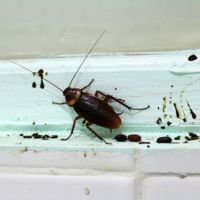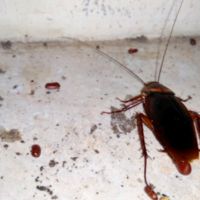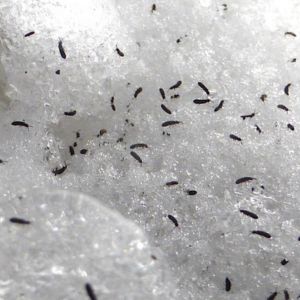How To Kill Cockroach Eggs
How To Kill Cockroach Eggs. Dealing with a cockroach infestation involves not only eliminating adult cockroaches but also addressing their eggs to prevent future generations. Cockroach eggs are a critical aspect of eradicating an infestation, as they can be hidden in various nooks and crannies within your home.
To effectively rid your living space of these persistent pests, it’s crucial to employ a comprehensive approach that targets both adult cockroaches and their eggs.
Understanding the life cycle of a cockroach is key to combating their eggs effectively. Cockroaches are notorious for their ability to reproduce rapidly, with each female capable of laying multiple egg cases, known as oothecae, throughout her lifespan.
Each ootheca can contain numerous eggs, making it imperative to adopt proactive measures that encompass sanitation, sealing entry points, and utilizing targeted insecticides to eradicate cockroach eggs and break the reproductive cycle.
Related: Can You Squish A Cockroach
How To Kill Cockroach Eggs

Understanding how to effectively eliminate cockroach eggs is vital in eradicating infestations and preventing future generations of these resilient pests.
Effective Strategies to Eliminate Cockroach Eggs
Discovering and eliminating cockroach eggs is a critical step in eradicating infestations and maintaining a pest-free environment. Employing targeted approaches to locate and eradicate these eggs is essential for effective pest control.
1. Thorough Cleaning: Start by conducting a deep clean of your living space. Focus on areas prone to cockroach infestation, such as kitchen cabinets, bathroom corners, and behind appliances. Use appropriate cleaning agents to disinfect and remove any potential eggs.
2. Vacuuming: Vacuuming is an effective way to physically remove eggs from carpets, cracks, and crevices. Utilize vacuum attachments to reach into tight spaces and ensure a thorough cleaning process. Be sure to dispose of the vacuum bag immediately to prevent any potential re-infestation.
3. Insecticidal Sprays: Utilize insecticidal sprays designed to kill cockroaches and their eggs. Apply these sprays in areas where eggs may be concealed, such as cracks, corners, and other hiding spots. Follow the instructions carefully for effective use.
4. Boric Acid: Boric acid is a well-known and effective cockroach killer, including their eggs. Create a boric acid paste and apply it in areas where cockroaches are likely to lay eggs. Be cautious in using this method in households with pets or small children.
5. Professional Extermination: Consider hiring a professional pest control service for a comprehensive and targeted approach. Pest control experts have the knowledge, tools, and techniques to locate and eliminate cockroach eggs effectively, providing long-term relief from infestations.
By combining these strategies and persistently addressing potential egg-laying sites, you can significantly enhance your efforts to eliminate cockroach eggs and disrupt the life cycle of these resilient pests, ultimately achieving a cockroach-free living space.
Cockroach Nesting Habits: Preferred Egg-Laying Sites

Cockroaches are highly adaptable insects with specific preferences when it comes to selecting sites for egg-laying, aiming for dark, warm, and secluded spaces.
1. Cracks and Crevices: Cockroaches tend to deposit their egg cases (oothecae) in tight cracks and crevices, often found near baseboards, behind cabinets, or within wall voids. These concealed spaces provide protection and warmth, ideal for their eggs to develop.
2. Kitchen and Bathroom Areas: Areas near the kitchen and bathroom, particularly around sinks, plumbing lines, and electrical outlets, are favored spots for egg-laying. The warmth and proximity to water sources attract cockroaches to lay eggs in these locations.
3. Appliances and Electronics: Warm electronic devices and household appliances create a suitable environment for cockroach eggs. Behind refrigerators, ovens, microwaves, and other appliances are common spots for them to lay their eggs undisturbed.
4. Cardboard and Paper: Cockroaches are known to lay eggs in and around cardboard boxes, paper stacks, or other paper materials. These items provide both a hiding place and potential food sources for the roaches and their offspring.
5. Storage Areas: Dark and rarely accessed storage spaces, such as attics, basements, or sheds, are attractive to cockroaches for egg-laying. They seek out secluded corners and piles of stored items to hide their eggs.
Understanding these preferred egg-laying sites helps in identifying and targeting areas for effective cockroach control and prevention. Regular cleaning, sealing entry points, and using insecticides in these key locations can disrupt their reproductive cycle and mitigate infestations.
Preventing Cockroach Egg Infestations: Strategic Measures
To thwart the proliferation of cockroaches and their resilient eggs within your living space, implementing preventive measures focused on sanitation, sealing, and targeted treatments is crucial.
1. Maintain Impeccable Hygiene: Regular cleaning and maintenance are essential to minimize potential cockroach breeding grounds. Thoroughly clean kitchens, bathrooms, and living areas, paying particular attention to spills, crumbs, and food residue. Dispose of garbage promptly and maintain a clutter-free environment.
2. Seal Entry Points: Cockroaches can squeeze through tiny openings. Seal cracks, gaps, and crevices in walls, windows, doors, and plumbing or electrical entry points using caulk or sealant. This denies cockroaches access and reduces hiding spots for laying eggs.
3. Secure Food and Water Sources: Cockroaches are attracted to food and water. Store food in airtight containers, fix leaky pipes, and keep sinks and drains dry. Limiting their access to these essentials discourages them from staying and laying eggs.
4. Regular Inspections and Pest Control: Conduct routine checks in potential cockroach nesting areas, even if no infestation is evident. Consider professional pest control services for regular inspections and targeted treatments to deter cockroaches and eliminate their eggs effectively.
5. De-Clutter and Reduce Hiding Spots: Reduce unnecessary clutter in your home, especially in storage areas. Cockroaches seek secluded spots to lay eggs, so minimizing hiding places discourages infestations. Keep rooms well-organized and free of unnecessary materials.
By implementing these proactive measures, you create an environment that is hostile to cockroaches and disrupts their ability to lay eggs, thereby aiding in the prevention of cockroach infestations.
Final Thoughts
Effectively preventing cockroach egg infestations necessitates a multi-faceted approach focused on hygiene, sealing potential entry points, managing food and water sources, regular inspections, and reducing hiding spots. Maintaining a clean and organized living environment, coupled with regular pest control checks, significantly diminishes the likelihood of cockroaches establishing breeding sites and laying eggs. By taking these proactive steps, you can effectively mitigate the risk of infestations, ensuring a healthier and more hygienic living space for you and your family.




